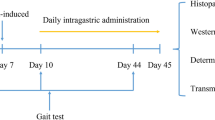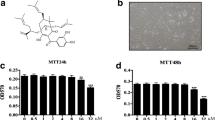Abstract
Osteoarthritis is the most prevalent form of arthritis, affecting a large part of population. It has been reported that muscle weakness and inflammation contribute to osteoarthritis development and progression. Oxidative stress plays important roles in muscle dysfunction and inflammation induction. Crocin, a component of saffron, has excellent antioxidative property. However, it is unclear if crocin can be a potential medicine for osteoarthritis therapy. Osteoarthritis in rats was induced by meniscectomy (MNX) surgery. Then, rats were given with 30 mg/kg of crocin daily for 10 days after osteoarthritis induction. The parameters were determined 7 days after crocin administration. MNX surgery induced osteoarthritis in rats. Crocin treatment significantly decreased osteoarthritis-associated joint pain, decreased muscular interleukin-6 (IL-6) level, and increased citrate synthase (CS) activity, as well as myosin heavy chain (MHC) IIα expression. In addition, crocin reduced muscular lipid peroxidation (LPO) and Nrf2 expression and increased glutathione production and glutathione peroxidase activity. Finally, crocin inhibited the activity of JNK, but not ERK, to repress NF-κB activation and inflammation induction. Crocin attenuates osteoarthritis symptoms through alleviating oxidative stress and inflammation, suggesting that crocin is a potential medicine for osteoarthritis therapy.





Similar content being viewed by others
References
Loeser, R.F., S.R. Goldring, C.R. Scanzello, and M.B. Goldring. 2012. Osteoarthritis: a disease of the joint as an organ. Arthritis and Rheumatism 64: 1697–1707.
Chen, D., J. Shen, W. Zhao, T. Wang, L. Han, J.L. Hamilton, et al. 2017. Osteoarthritis: Toward a comprehensive understanding of pathological mechanism. Bone Research 5: 16044.
Malfait, A.M. 2016. Osteoarthritis year in review 2015: biology. Osteoarthritis and Cartilage 24: 21–26.
Pennock, A.T., C.M. Robertson, B.C. Emmerson, F.L. Harwood, and D. Amiel. 2007. Role of apoptotic and matrix-degrading genes in articular cartilage and meniscus of mature and aged rabbits during development of osteoarthritis. Arthritis and Rheumatism 56: 1529–1536.
Hsu, D.Z., P.Y. Chu, P.T. Wu, P.C. Shen, and I.M. Jou. 2015. Oxidative stress participates in quadriceps muscle dysfunction during the initiation of osteoarthritis in rats. International Journal of Clinical and Experimental Pathology 8: 12491–12499.
Callahan, D.M., M.S. Miller, A.P. Sweeny, T.W. Tourville, J.R. Slauterbeck, P.D. Savage, et al. 2014. Muscle disuse alters skeletal muscle contractile function at the molecular and cellular levels in older adult humans in a sex-specific manner. The Journal of Physiology 592: 4555–4573.
Milei, J., P. Forcada, C.G. Fraga, D.R. Grana, G. Iannelli, M. Chiariello, et al. 2007. Relationship between oxidative stress, lipid peroxidation, and ultrastructural damage in patients with coronary artery disease undergoing cardioplegic arrest/reperfusion. Cardiovascular Research 73: 710–719.
Ma, Q. 2013. Role of nrf2 in oxidative stress and toxicity. Annual Review of Pharmacology and Toxicology 53: 401–426.
Kaplowitz, N., T.Y. Aw, and M. Ookhtens. 1985. The regulation of hepatic glutathione. Annual Review of Pharmacology and Toxicology 25: 715–744.
Christodoulou, E., N.P. Kadoglou, N. Kostomitsopoulos, and G. Valsami. 2015. Saffron: a natural product with potential pharmaceutical applications. The Journal of Pharmacy and Pharmacology 67: 1634–1649.
Ding, Q., H. Zhong, Y. Qi, Y. Cheng, W. Li, S. Yan, et al. 2013. Anti-arthritic effects of crocin in interleukin-1beta-treated articular chondrocytes and cartilage in a rabbit osteoarthritic model. Inflammation Research 62: 17–25.
Hsu, D.Z., P.Y. Chu, and I.M. Jou. 2016. Daily sesame oil supplement attenuates joint pain by inhibiting muscular oxidative stress in osteoarthritis rat model. The Journal of Nutritional Biochemistry 29: 36–40.
Mihara, M., S. Higo, Y. Uchiyama, K. Tanabe, and K. Saito. 2007. Different effects of high molecular weight sodium hyaluronate and NSAID on the progression of the cartilage degeneration in rabbit OA model. Osteoarthritis and Cartilage 15: 543–549.
Iacono, A., R. Gomez, J. Sperry, J. Conde, G. Bianco, R. Meli, et al. 2010. Effect of oleocanthal and its derivatives on inflammatory response induced by lipopolysaccharide in a murine chondrocyte cell line. Arthritis and Rheumatism 62: 1675–1682.
Avruch, J. 2007. MAP kinase pathways: the first twenty years. Biochimica et Biophysica Acta 1773: 1150–1160.
Berenbaum, F. 2004. Signaling transduction: target in osteoarthritis. Current Opinion in Rheumatology 16: 616–622.
Bostan, H.B., S. Mehri, and H. Hosseinzadeh. 2017. Toxicology effects of saffron and its constituents: a review. Iranian Journal of Basic Medical Sciences 20: 110–121.
Yu, S.P., and D.J. Hunter. 2016. Intra-articular therapies for osteoarthritis. Expert Opinion on Pharmacotherapy 17: 2057–2071.
Song, I.H., C.E. Althoff, K.G. Hermann, A.K. Scheel, T. Knetsch, G.R. Burmester, et al. 2009. Contrast-enhanced ultrasound in monitoring the efficacy of a bradykinin receptor 2 antagonist in painful knee osteoarthritis compared with MRI. Annals of the Rheumatic Diseases 68: 75–83.
Nam, K.N., Y.M. Park, H.J. Jung, J.Y. Lee, B.D. Min, S.U. Park, et al. 2010. Anti-inflammatory effects of crocin and crocetin in rat brain microglial cells. European Journal of Pharmacology 648: 110–116.
Ikeda, S., H. Tsumura, and T. Torisu. 2005. Age-related quadriceps-dominant muscle atrophy and incident radiographic knee osteoarthritis. Journal of Orthopaedic Science 10: 121–126.
Bertaggia, E., G. Scabia, S. Dalise, F. Lo Verso, F. Santini, P. Vitti, et al. 2014. Haptoglobin is required to prevent oxidative stress and muscle atrophy. PloS One 9: e100745.
Shi, Y., M.V. Ivannikov, M.E. Walsh, Y. Liu, Y. Zhang, C.A. Jaramillo, et al. 2014. The lack of CuZnSOD leads to impaired neurotransmitter release, neuromuscular junction destabilization and reduced muscle strength in mice. PloS One 9: e100834.
Ochiai, T., H. Shimeno, K. Mishima, K. Iwasaki, M. Fujiwara, H. Tanaka, et al. 2007. Protective effects of carotenoids from saffron on neuronal injury in vitro and in vivo. Biochimica et Biophysica Acta 1770: 578–584.
Acknowledgments
This study was supported by Food and Drug Administration of Hebei Province 2014 Annual Food and Drug Safety Science and Technology Project Plan (PT2014026).
Author information
Authors and Affiliations
Corresponding author
Ethics declarations
Conflict of Interest
The authors declare that they have no conflict of interest.
Research Involving Human Participants and/or Animals
All applicable international, national, and/or institutional guidelines for the care and use of animals were followed.
Informed Consent
Not applicable.
Funding
This study was supported by Food and Drug Administration of Hebei Province 2014 Annual Food and Drug Safety Science and Technology Project Plan (PT2014026).
Rights and permissions
About this article
Cite this article
Lei, M., Guo, C., Hua, L. et al. Crocin Attenuates Joint Pain and Muscle Dysfunction in Osteoarthritis Rat. Inflammation 40, 2086–2093 (2017). https://doi.org/10.1007/s10753-017-0648-8
Published:
Issue Date:
DOI: https://doi.org/10.1007/s10753-017-0648-8




